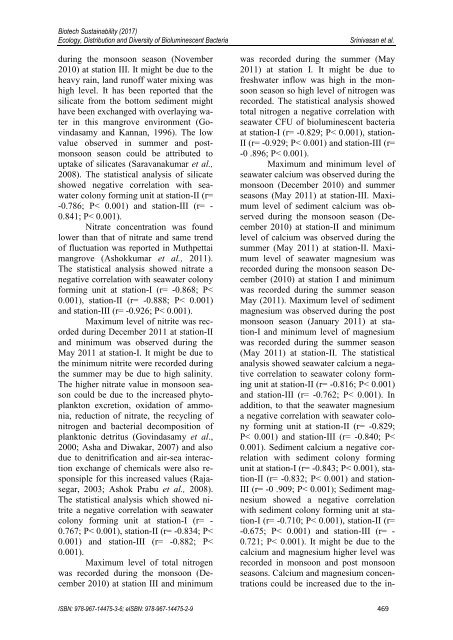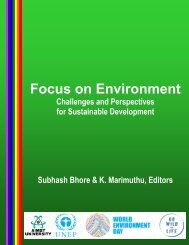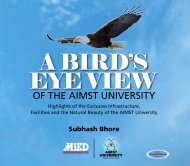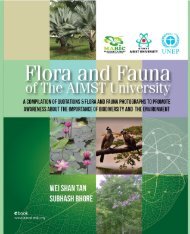Biotechnology for Sustainability: Achievements, Challenges and Perspectives
World Environment Day (WED) is a global annual event celebrated each year on June 5 to promote the awareness about the importance of preserving the environment. This book is published to commemorate the world environment day-2017 (WED-2017). The main purpose of this book is to highlight – how biotechnology can contribute for the sustainable development and in achieving sustainable development goals (SDGs) adapted by the international community to improve the health of people and planet? This book contains 38 full-length articles contributed by various researchers, scientists and academicians. A prudent use of biotechnology in the biodiversity conservation, environmental protection, and production of more and better quality of food, fiber, fuel and drugs will contribute in achieving SDGs and to promote the peace in the world. This book will serve as a reference to various researchers, scientists, academicians and students involved in biodiversity conservation, environmental protection and various fields of biology and biotechnology.
World Environment Day (WED) is a global annual event celebrated each year on June 5 to promote the awareness about the importance of preserving the environment. This book is published to commemorate the world environment day-2017 (WED-2017). The main purpose of this book is to highlight – how biotechnology can contribute for the sustainable development and in achieving sustainable development goals (SDGs) adapted by the international community to improve the health of people and planet? This book contains 38 full-length articles contributed by various researchers, scientists and academicians. A prudent use of biotechnology in the biodiversity conservation, environmental protection, and production of more and better quality of food, fiber, fuel and drugs will contribute in achieving SDGs and to promote the peace in the world. This book will serve as a reference to various researchers, scientists, academicians and students involved in biodiversity conservation, environmental protection and various fields of biology and biotechnology.
Create successful ePaper yourself
Turn your PDF publications into a flip-book with our unique Google optimized e-Paper software.
Biotech <strong>Sustainability</strong> (2017)<br />
Ecology, Distribution <strong>and</strong> Diversity of Bioluminescent Bacteria<br />
during the monsoon season (November<br />
2010) at station III. It might be due to the<br />
heavy rain, l<strong>and</strong> runoff water mixing was<br />
high level. It has been reported that the<br />
silicate from the bottom sediment might<br />
have been exchanged with overlaying water<br />
in this mangrove environment (Govindasamy<br />
<strong>and</strong> Kannan, 1996). The low<br />
value observed in summer <strong>and</strong> postmonsoon<br />
season could be attributed to<br />
uptake of silicates (Saravanakumar et al.,<br />
2008). The statistical analysis of silicate<br />
showed negative correlation with seawater<br />
colony <strong>for</strong>ming unit at station-II (r=<br />
-0.786; P< 0.001) <strong>and</strong> station-III (r= -<br />
0.841; P< 0.001).<br />
Nitrate concentration was found<br />
lower than that of nitrate <strong>and</strong> same trend<br />
of fluctuation was reported in Muthpettai<br />
mangrove (Ashokkumar et al., 2011).<br />
The statistical analysis showed nitrate a<br />
negative correlation with seawater colony<br />
<strong>for</strong>ming unit at station-I (r= -0.868; P<<br />
0.001), station-II (r= -0.888; P< 0.001)<br />
<strong>and</strong> station-III (r= -0.926; P< 0.001).<br />
Maximum level of nitrite was recorded<br />
during December 2011 at station-II<br />
<strong>and</strong> minimum was observed during the<br />
May 2011 at station-I. It might be due to<br />
the minimum nitrite were recorded during<br />
the summer may be due to high salinity.<br />
The higher nitrate value in monsoon season<br />
could be due to the increased phytoplankton<br />
excretion, oxidation of ammonia,<br />
reduction of nitrate, the recycling of<br />
nitrogen <strong>and</strong> bacterial decomposition of<br />
planktonic detritus (Govindasamy et al.,<br />
2000; Asha <strong>and</strong> Diwakar, 2007) <strong>and</strong> also<br />
due to denitrification <strong>and</strong> air-sea interaction<br />
exchange of chemicals were also responsiple<br />
<strong>for</strong> this increased values (Rajasegar,<br />
2003; Ashok Prabu et al., 2008).<br />
The statistical analysis which showed nitrite<br />
a negative correlation with seawater<br />
colony <strong>for</strong>ming unit at station-I (r= -<br />
0.767; P< 0.001), station-II (r= -0.834; P<<br />
0.001) <strong>and</strong> station-III (r= -0.882; P<<br />
0.001).<br />
Maximum level of total nitrogen<br />
was recorded during the monsoon (December<br />
2010) at station III <strong>and</strong> minimum<br />
Srinivasan et al.<br />
was recorded during the summer (May<br />
2011) at station I. It might be due to<br />
freshwater inflow was high in the monsoon<br />
season so high level of nitrogen was<br />
recorded. The statistical analysis showed<br />
total nitrogen a negative correlation with<br />
seawater CFU of bioluminescent bacteria<br />
at station-I (r= -0.829; P< 0.001), station-<br />
II (r= -0.929; P< 0.001) <strong>and</strong> station-III (r=<br />
-0 .896; P< 0.001).<br />
Maximum <strong>and</strong> minimum level of<br />
seawater calcium was observed during the<br />
monsoon (December 2010) <strong>and</strong> summer<br />
seasons (May 2011) at station-III. Maximum<br />
level of sediment calcium was observed<br />
during the monsoon season (December<br />
2010) at station-II <strong>and</strong> minimum<br />
level of calcium was observed during the<br />
summer (May 2011) at station-II. Maximum<br />
level of seawater magnesium was<br />
recorded during the monsoon season December<br />
(2010) at station I <strong>and</strong> minimum<br />
was recorded during the summer season<br />
May (2011). Maximum level of sediment<br />
magnesium was observed during the post<br />
monsoon season (January 2011) at station-I<br />
<strong>and</strong> minimum level of magnesium<br />
was recorded during the summer season<br />
(May 2011) at station-II. The statistical<br />
analysis showed seawater calcium a negative<br />
correlation to seawater colony <strong>for</strong>ming<br />
unit at station-II (r= -0.816; P< 0.001)<br />
<strong>and</strong> station-III (r= -0.762; P< 0.001). In<br />
addition, to that the seawater magnesium<br />
a negative correlation with seawater colony<br />
<strong>for</strong>ming unit at station-II (r= -0.829;<br />
P< 0.001) <strong>and</strong> station-III (r= -0.840; P<<br />
0.001). Sediment calcium a negative correlation<br />
with sediment colony <strong>for</strong>ming<br />
unit at station-I (r= -0.843; P< 0.001), station-II<br />
(r= -0.832; P< 0.001) <strong>and</strong> station-<br />
III (r= -0 .909; P< 0.001); Sediment magnesium<br />
showed a negative correlation<br />
with sediment colony <strong>for</strong>ming unit at station-I<br />
(r= -0.710; P< 0.001), station-II (r=<br />
-0.675; P< 0.001) <strong>and</strong> station-III (r= -<br />
0.721; P< 0.001). It might be due to the<br />
calcium <strong>and</strong> magnesium higher level was<br />
recorded in monsoon <strong>and</strong> post monsoon<br />
seasons. Calcium <strong>and</strong> magnesium concentrations<br />
could be increased due to the in-<br />
ISBN: 978-967-14475-3-6; eISBN: 978-967-14475-2-9 469







